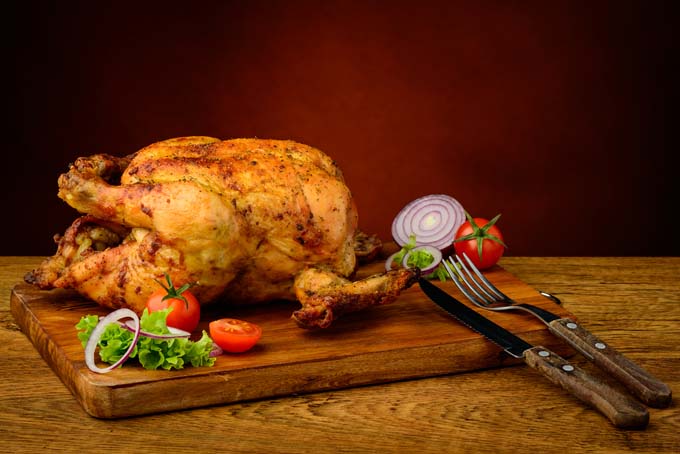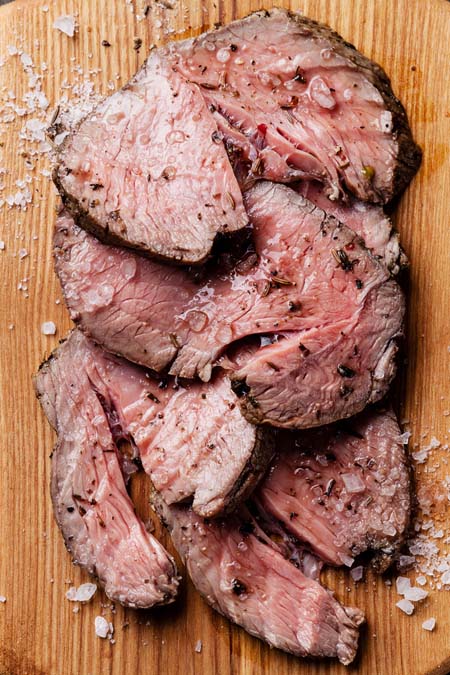Cooking meat can be a mystery to many people. Those new to cooking, of course, are to forgiven easily for not realizing exactly what kind of time must be given for roasting a chicken or broiling a steak.

There are also those who are quite proficient and adept at knowing just the exact moment to retrieve a chicken from the oven so that is juicier than a watermelon, but at the same time, are clueless as to how long a pork tenderloin can be left in that same oven before it becomes useful only as an implement of murder in a small Cape Cod home on Nantucket.
This article is intended to be a kind of Rosetta Stone that unlocks the mystery of how long you should cook a particular kind of meat. You really should purchase a good quality meat thermometer as well, for optimal results and safety.
Roasting Chicken
The standard rule of thumb for roasting chicken is to preheat the oven to 350°F and let it cook for 30 minutes per pound. Unless, that is, the chicken has been stuffed (which it never should be, according to a guy who should know, Alton Brown).
Nevertheless, people will continue stuffing chicken, so it’s a good thing to know that you should add anywhere from fifteen to thirty minutes to the total cooking time.
Roasting Turkey
You might think turkey should be roasted along the same lines as chicken. Both are fowl, right? But if you treat turkey like chicken in the roasting process, or vice versa, what you may be left with is something foul indeed.
In the first place, the perfect roasted turkey will required that the oven is preheated to 325°F rather than 350°F. A turkey that weighs between 4 and 8 pounds should be cooked anywhere from 3 to 4 hours.
If the turkey weighs 8 to 12 pounds, then cook for between 4 and 4 ½ hours. If the turkey weighs between 12 and 16 pounds, then you can go up to 5 hours. A turkey weighing between 16 and 20 pounds should be roasted from 6 to 7 ½ hours. A big honking turkey between 20 and 24 pounds needs up to 9 hours. Anything larger than 24 pounds, and you’re going to be running that oven for most of your waking hours.
Beef Rib-Eye
Most roast beef cuts, except for tenderloin, should be cooked at 350°F. Tenderloin, by contrast, needs to be roasted at 400°F. For beef rib-eye between 4 and 6 pounds, the length of cooking time is based on whether you enjoy drinking blood while you eat meat, or whether you like your meat cooked all the way through. For a rare rib-eye, cook for 20 minutes per pound and make sure the internal temperature gets to 140°F.
A medium beef rib-eye should be cooked 22 minutes per pound, and the internal temperature needs to reach 160°F. If you prefer your meat to actually be cooked all the way through rather than being a bloody mess, cook a beef rib-eye for 24 minutes per pound, and make sure the internal temperature reaches 170°F.
Standing Rib Roast
Standing rib roast should be cooked 20 to 25 minutes per pound, and needs to reach an internal temperature of 140°F if you like it rare. For medium rib roast, aim for 25 to 30 minutes with an internal temp that gets to 160°F. For a well done rib roast with a deliciously crunchy exterior, cook 30 to 35 minutes so that the internal temperature gets up to 170°F.
Tenderloin
Again, beef tenderloin should be roasted at 400°F. For a whole tenderloin of 4 to 6 pounds, cook for 10 minutes per pound so that the temperature on the inside reaches 140°F. That internal temperature guide is the same for a half tenderloin of 2 to 3 pounds. The half slab needs to cook for 20 minutes per pound.
Roasted Pork
To roast pork loin you always want to make sure the internal temperature climbs to 180°F. To do this, preheat the oven to 350°F and cook a center cut for 40 minutes per pound.
Cook a pork loin that weighs 5 to 7 pounds for 45 minutes per pound. Cook a rolled pork loin that weighs between 3 to 5 pounds for 50 minutes per pound.
Pork spareribs should be cooked for 40 minutes per pound. A fresh leg of ham that weighs from 10 to 14 pounds should be cooked for 30 minutes per pound, while a fresh ham weighing 5 to 7 pounds should be cooked 40 minutes per pound.
Whole Ham
A whole ham that weighs 10 to 14 pounds and that is uncooked needs to reach an internal temperature of 160°F. This means cooking it for 20 minutes per pound. But what about those hams that are already fully cooked?
These pre-cooked hams can be confusing to some people. After all, if they are already fully cooked, can’t you just slice and serve? Maybe, but it’s always better to be safe than risk trichinosis. For this reason, you want to defy logic by cooking a fully-cooked whole ham for 15 minutes per pound, so that the internal temperature reaches 130°F.
Roasted Duck and Goose
Roasting ducks and geese never quite caught in America the way that it did among our British ancestors, at least not among the middle and lower classes. Perhaps this is because of the greasiness of duck.
I’ve never tried goose, so I cannot comment. I did try to cook a duck once and, well, it just did not happen; at least not to my own satisfaction.
The rule of thumb for cooking goose or duck is to fire that oven up to 350°F and cook the fowl for 30 minutes per pound. Just be prepared for your first attempt to fail to attain the level of delight that you get from chicken or turkey. It may take a few attempts and some trial and error before you finally get it right.
Roasted Veal
Confession time: I have never eaten veal in my life. At least not that I’m aware of.
If you want to roast veal, then set your oven to 325°F. You want the internal temperature to reach 170°F, and you can accomplish this by cooking a leg from 25 to 30 minutes per pound; by cooking veal loin from 30 to 35 minutes per pound; and cooking a rack of veal ribs from 35 to 40 minutes per pound.
As you can see, various kinds of meats have very different roasting times and temperatures. I hope this guide has been some help to you.
Bon Appétit!
–Lynne
About Lynne Jaques
Lynne is a stay-at-home mother of two boys. As a former US military officer and the spouse of an active duty US military member, Lynne enjoys traveling the world (although not the moving part!) and finding new cuisine and methods of preparing food. She also has the habit of using parenthesis way too much!





Now am hungry and am craving me some meat…darn its too late to head to the meat store, kind of wishing the festive season was dawning upon us by tomorrow so that i can eat and indulge all the way {antacids within arms length 🙂 }…thank you for the tips on how to roast different types of meat…yes, i confess, am clueless when it comes to cooking meat, at most times, its overly cooked, i end up leaving the kitchen with a sad tired disposition and undertone grumbling and excessive mumbling :(…well gladly that is over now, thanks to foodal.com 🙂
I am from the South, so, naturally I want every meat to be fried. I know that there are healthier alternatives and I have wandered into the Whole Foods a few times in search of alternatives, for the sake of my health. So, I accept the Roasting Guide as my hallmark for change. I usually avoided roasting because I was clueless about the proper roasting times to maintain moistness. Now, I will brave the new world with my Roasting Guide in hand. I really enjoyed your article, Lynne. Thanks and my heart thanks you. 😉
I learned a lot from the article! I thought that roasting is an easy way to cook beef, pork and chicken but then, it’ll be only perfectly served based cooking times or internal temperature and weigh, for an enhanced tender and juicy flavor. I will have to book marked this one!
Thank you for this comprehensive guide. I roast whole chickens fairly often but not so much other proteins. Subsequently, I have to look up how to do it every single time. There are so many different temperatures and times to remember. Now I’ll just bookmark this page for easy look up when I roast meat next. 🙂 Awesome!
What a well thought out, hugely informative guide. I’m going to print this and stick it in my cookbook as a cheat sheet. Thanks!
This is a very comprehensive guide to proper cooking times for meat. i have always had a hard time getting meat cooked to a proper temperature without overdoing it. For anyone new to cooking I would definitely recommend a good meat thermometer.
Thanks for this guide. It is definitely tricky for new cooks to figure out the best times for meats. Remember though that ovens vary and things such colder days can effect cooking time! My advice would be to invest in a meat thermometer and check near the end of cooking time whether the time has reached its cooked temperature.
That’s a really comprehensive guide thank you! I’m pleased to see the inclusion of veal as well – I have always wanted to try cooking it myself.
I had a difficult time with beef wellington &, as you all know, that’s a tough (expensive) thing to screw up time & time again. I like that you included the way you prefer your cook into the time allotted TO cook it. Thanks for the tips.
Ooooh, why didn’t I notice this already? This is hugely helpful. Even though I’ve been cooking for a long, long time, I seem to draw a blank when it comes to preparing certain types of meat. This is especially true around the holidays. I mean, I KNOW how to cook a turkey or ham, but when it comes time to prepare it, I’m at a loss.
This guide will come in very handy. Bookmarking this page right now.
I remember when I started cooking more seriously that I had trouble with my timing and preparation. I always had to look up the exact recipe, otherwise I was disoriented. Once you prepare food for a long time things will just sink into your subconcious mind, but this article is very comprehensive and well-written for starters!
When it comes to roasting I am probably one of the worst, because I am always the type of person who cannot just let things sit and cook. I will always be peeking in and checking on it, wanting to take the temperature every five minutes or so. That said, though, I figure that having the times and settings right there laid for me would certainly help me out, so for that I say thank you for sharing. It is always a delicious way to cook and gives some juicy meat, so I will have to utilize this. Thanks again.